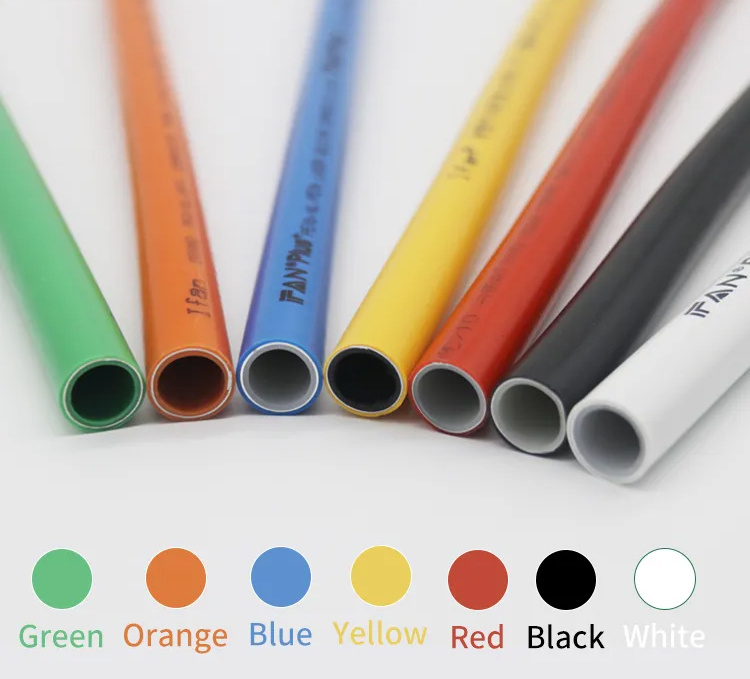What is Better – PEX or Copper?
Comparing the Pros and Cons of Both Piping Materials for Plumbing Systems
Both crosslinked polyethylene (PEX) and copper offer time-proven piping materials for residential and commercial plumbing systems. But what is better – PEX or copper? This article examines the key differences in performance, cost factors, and suitability for different applications.IFAN factory with 30+ years of manufacturing experience supports color/size customization and free samples. Welcome to consult for catalog and free samples. This is our Facebook Website: www.facebook.com.

Temperature Resistance Comparison
PEX maintains its strength and flow at temperatures up to 200°F. Copper can safely handle exposure beyond 250°F, making it preferable for steam lines and closest connections to heat sources.
For applications like general water heating plumbing, PEX, and copper both sufficiently withstand typical 120°F to 140°F water. For very high-temperature needs, copper has the edge.
Pressure Rating Comparison
Copper tubing can come in pressure ratings between 150 PSI to 850 PSI depending on wall thickness. PEX pressure ratings range from 100 PSI to 160 PSI.
For high-rise building plumbing with pressure requirements over 160 PSI, copper remains the only option. However for typical residential service pressures, PEX pressure capacity is sufficient.
Freeze Resistance Comparison
Both PEX and copper pipes are prone to bursting if the water inside freezes and expand. However, flexible PEX is better able to handle freeze-thaw cycles and temperature fluctuations.
In cold regions, PEX’s elasticity makes it less likely to rupture from ice expansion stresses. Copper becomes brittle when frozen. Careful installation is required in either case.
Corrosion Resistance Comparison
PEX and copper both resist corrosion from normal water exposure and aggressive water treatment chemicals. Neither material reacts with or contaminates drinking water.
However, some groundwater and acidic conditions can erode copper over extended periods. PEX polyethylene withstands more pH extremes without corrosion or permeation issues.
Installation Comparison
PEX allows much faster installation than copper, with simpler press connections or crimp rings rather than soldering and fluxing. PEX also eliminates fire risks from torches.
DIYers can install PEX but usually avoid copper work. PEX flexibility also simplifies routing through framing and around obstructions compared to rigid pipes.
For professional plumbers, PEX provides substantial labor savings on connections, lowering total installed costs despite somewhat higher material costs.
Leak and Repair Comparison
Pinhole leaks can develop in copper pipes over time requiring repair. Complete PEX failures are rare but do require re-piping the entire failed segment when they occur.
PEX repairs involve greater effort and cost when needed. However, the overall lower leak and failure rate of PEX may offset this disadvantage for many plumbing systems.
Appearance Comparison
For exposed decorative plumbing like in kitchens, copper provides an attractive finish appearance. PEX tubing looks utilitarian when visible.
But for most concealed supply plumbing behind walls and under floors, appearance matters less. PEX can be paired with copper just for final fixture connections to give an appealing finish.
Environmental Impact Comparison
Copper mining and smelting proves more environmentally disruptive than manufacturing PEX from abundant natural gas and salt. PEX also allows plumbing using fewer fittings and less energy to install.
PEX production and use have a lower carbon footprint. Offsetting copper’s high recycling rate, PEX offers more sustainable plumbing overall in many regards.
Supply Chain and Availability Comparison
The prevalence of copper in plumbing spans over a century. PEX gained U.S. approval starting in the 1980s and continues gaining adoption. PEX supply chains are less established in some areas.
For plumbers preferring local sources, copper may currently offer better product availability. However, PEX distributors continue to expand as PEX becomes more commonplace.
Cost Comparison
Copper tubing material costs less per linear foot than PEX in most sizes. However, PEX offers substantial labor savings on connections during installation. Total installed PEX costs can be lower than copper.
As PEX gains economies of scale, its material pricing disadvantage is diminishing. And pre-sleeved PEX simplifies design by eliminating measuring and cutting labor.
Key Applications Favoring PEX or Copper
Based on their specific strengths, builders can choose the optimal piping material:
- Use PEX for most supply plumbing not exposed to extreme temperatures.
- Specify copper for exposed decorative plumbing, steam lines, and high-pressure systems.
- Choose PEX for radiant floor heating for flexibility and corrosion resistance.
- Utilize copper in specialized chemical drainage systems due to pH resistance.
- Select PEX for frequent minor plumbing modifications due to simple connections.
The ideal choice depends on temperature, pressure, chemicals, installation effort, aesthetics, and cost considerations for each unique plumbing application.
Weighing the Evidence For Residential and Commercial Plumbing
ForBelowGradeWikipediaArticlesubsections help organize information in a readable way. Links provide citations to sources, and images can illustrate key points. An objective tone presents the facts to allow readers to evaluate and decide for themselves.
IFAN
IFAN factory started in 1993. And IFAN has a workshop of 120000 square meters with 610 staff. IFAN can design and produce all plumbing pipe and fitting including PPR, PVC, CPVC PPSU HDPE PEXA PEXB PERT pipe and fitting, brass fitting, brass ball valve, heating system, gas system, sanitary faucets, and hose, In the past 30 years, IFAN has never forgotten his mission-To protect health and safety. And IFAN factory uses the best materials to produce high-quality pipe and fittings with an automatic production line and high-tech quality control machines.

